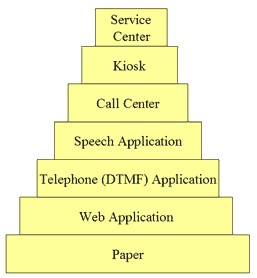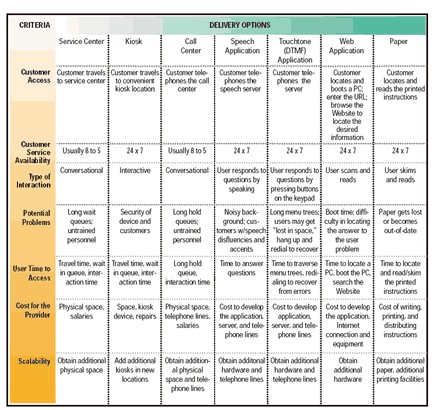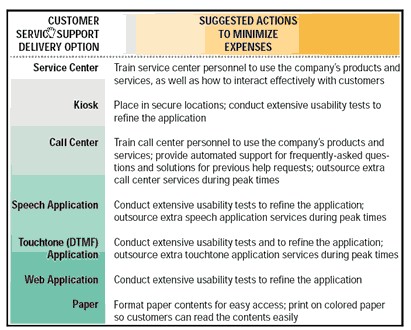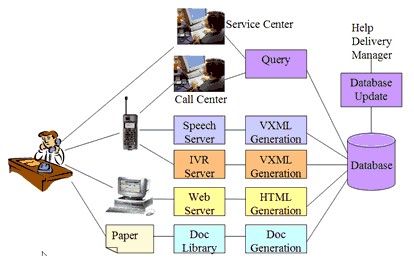|
|


IVR Solutions
This section of our technical library presents information and documentation relating to IVR Development and custom IVR software and products.
Business phone systems and toll free answering systems (generally 800 numbers and their equivalent) are very popular for service and sales organizations, allowing customers and prospects to call your organization anywhere in the country.
The PACER and WIZARD IVR System is just one of many DSC call center phone system features..
What is IVR Software?. An Interactive Voice Response (IVR) processes inbound phone calls, plays recorded messages including information extracted from databases and the internet, and potentially routes calls to either inhouse service agents or transfers the caller to an outside extension.
Contact DSC today. to learn more about our IVR services and IVR application development software.
Balancing Customer Service Support Options
By James A. Larson
Intel Corporation
Customers often ask questions about products, services, delivery dates and account information, as well as, offer suggestions and complaints. If customers do not receive satisfactory answers to their questions, they become disillusioned with the company and take their business elsewhere. In short, good customer service support is the key to repeat business.
Customer service support delivery options
Customer support service delivery options form a hierarchy (See Figure 1), with the most expensive option (service center) at the top and the least expensive option (paper) at the bottom. Eager to keep current customers happy, many companies use several options to deliver customer support, including:

Figure 1 Typical Help Delivery Strategy
- Service center — A location, usually in the company’s store, where customers speak with human customer support agents.
- Kiosk — Devices located in highly visited areas (e.g., shopping malls) enabling customers to interact with multimodal applications and possibly with a live agent.
- Call center — A customer telephones a call center to speak with and listen to a human customer support agent.
- Speech application — A customer telephones a speech server to converse with an artificial agent that speaks and listens.
- Touchtone (DTMF) application — A customer telephones a DTMF server to listen to an artificial agent ask questions and responds by pressing the touchtone buttons on the telephone or cell phone keypad.
- Web application — A customer turns on a connected PC, then downloads and browses a Web document displaying information on a screen.
- Email – A customer sends an email question to the support center and receives an email response.
- Paper — A customer locates and reads instructions printed on box panels or in instruction manuals included with a product. The document may be enclosed with the product when purchased, faxed, e-mailed, or surface mailed to the customer.
Customer service support delivery option criteria
Management evaluates the effectiveness of customer support delivery options using a variety of criteria, including:
- Customer access — What action must the customer perform to obtain service?
- Customer service availability — When may the customer obtain service?
- Type of interaction — What is the nature of the dialog between customers and the support service facility? Customers may interact conversationally when they speak with a customer service support agent in a service or call center; send a freeform or a structured email and receive either or both back; listen to prerecorded instructions on a telephone; or read a monologue of instructions on a Web page or paper.
- Potential problems — What problems make it difficult for customers to obtain support services?
- User time to access — How much time and effort must the user spend to obtain the desired support?
- Cost for the provider — How much will each delivery option cost the enterprise?
- Scalability — How easily can the method be extended or enlarged to handle additional customers?
As you can see, Table 1 summarizes each customer support delivery option with respect to the above criteria. The article by Todd Strubbe (West) on page 24 describes the criteria for implementing applications in speech or using customer service centers. For information about a new conference in this area, Service Automation Expo (SAXPO), see pages 18-19.

Table 1: Comparison of Criteria for Alternative Support Delivery Options
Two competing goals
Many customers prefer the higher options in the customer service support hierarchy. Companies find it less expensive to provide the customer support delivery options lower in the hierarchy.
In general, companies attempt to balance two competing goals:
- Budget criteria — Companies maintain the overall expense below budget by encouraging customers to use the lower-cost customer service support delivery strategies. Because delivery options lower in the table are less expensive than the higher options, the same amount of money allocated to a lower delivery option will serve a larger number of customers.
- Customer satisfaction criteria — Companies maintain customer satisfaction above a specified threshold by enabling customers to elevate their service support requests to a higher-cost customer service support delivery option when the lower-cost option is not satisfactory.
Many companies choose to provide customer support with multiple customer support delivery options. A company’s customer support delivery strategy determines the relative amount of funding for each customer support delivery option. Please refer to Figure 1, which illustrates a typical customer support delivery strategy that enables customers to select from among several support delivery options. The size of the rectangle associated with each option indicates its share of the customer support budget.
Meeting both the budget and customer satisfaction criteria
Companies can satisfy the budget constraints by allocating large amounts of the budget to the lower-cost option, as illustrated in Figure 1. However, this strategy may result in excessive customer complaints because of lack of customer access to the higher-level, more expensive delivery options. Customer satisfaction can be improved by shifting some of the budget to more expensive options.
Techniques for managing customer use of the various delivery options include the following:
- Improve the performance of your individual customer service support delivery options. Refer to Table 2 for suggested actions to minimize expenses of each customer service support delivery option
- Ensure that all of your delivery techniques enable customers to obtain accurate and up-to-date information. Customer satisfaction can be raised for lower-cost options if they provide the same up-to-date information as higher-cost options. Figure 2 illustrates an integrated customer support system in which each delivery method obtains data from the same database. (See “Technology Trends: Developing Verbal, Visual, and Multimodel User Interfaces for the Same Application” in the November/December 2002 issue of Speech Technology Magazine.) All customers need current information, so the database must be kept up-to-date. Also, all systems access the same database; therefore, data delivered by each customer service support delivery option is consistent with data delivered by other delivery options.
- Control your customers’ abilities to switch among delivery options. Companies balance budget and customer satisfaction goals by controlling the availability of each customer service support delivery option and encouraging customers to upgrade or downgrade their customer support delivery choice. Table 3 summarizes for you the techniques for encouraging customers to switch among help delivery options.
- Upgrade to a newer technology. The sidebars summarize reasons for switching from touchtone (DTMF) to speech applications and for adopting natural language technology into your call center.

Table 2: Efficiency Techniques for Customer Service Support Delivery Options

Figure 2 Integrated Customer Service Support Delivery System
Establishing a customer service support strategy
How do you establish and implement a customer service support strategy? The basic planning steps are:
- Determine your company’s overall budget for delivering customer service support. This will establish a starting point for allocating funds to each of the customer service support delivery options.
- Allocate part of the budget to each customer service support delivery option, so all anticipated requests for customer service support are covered. Recall that resources allocated to the low-cost customer service support options satisfy more requests than the higher cost customer service support options.
- Determine if this allocation of funds among the various customer service support options satisfies your company’s goals for customer satisfaction. It may be necessary for you to allocate resources to higher-level customer service support delivery options to achieve maximum customer satisfaction levels.
- Decrease your expenses by optimizing the performance for each customer service support delivery option. Consider integrating the back-end process for each customer service support delivery option to increase consistency and deliver up-to-date customer service support information, as well as decrease overall customer service support delivery expenses.
- Maintain a resource reserve to handle emergency customer service support delivery options, which may occur if one of your products is recalled, world events result in increased calls for customer service support, or (preferable) your sales increase resulting in additional calls for customer service support.
Conclusion
A company balances the two competing goals of delivering support service via the most effective means while maintaining the overall budget. Options for delivering support services to customers include the use of service centers, call centers, speech applications, touchtone (DTMF) applications, Web applications, and paper. Criteria for evaluating the effectiveness of these options include customer access, customer service support availability, type of interaction, potential problems, user time to access, cost for the provider, and scalability. By minimizing the costs associated with each service support option and by encouraging users to upgrade or downgrade the service they use, companies control the overall budget allocated for support services.
Dr. James A. Larson is the co-chair of the World Wide Web Consortium Voice Browser Working Group that is standardizing VoiceXML and other languages for developing speech applications. He is the author of VoiceXML—Introduction to Developing Speech Applications, available from Prentice Hall and was co-program chair for SpeechTEK 2003 and 2004. Jim works part-time for Intel Corporation and presents workshops and seminars on developing speech applications. His Website is www.larson-tech.com.
|







